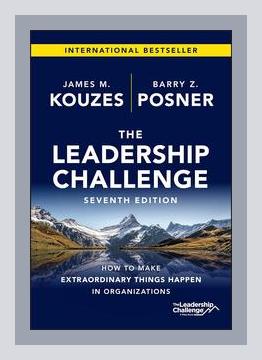Leadership and ManagementTeam Building
The Leadership Challenge: How to Make Extraordinary Things Happen in Organizations
Authors: James M. Kouzes, Barry Z. Posner
Category: Team Building
Publication Year: 1987
Introduction
“The Leadership Challenge” by James M. Kouzes and Barry Z. Posner is a seminal work in the field of leadership studies and team building. The authors provide a comprehensive framework for effective leadership that is built on five central practices. These practices are derived from extensive research involving thousands of leaders across various industries and organizations.
The Five Practices of Exemplary Leadership
1. Model the Way
Effective leadership starts with setting an example. Leaders must be clear about their own values and beliefs, as well as be willing to take a stand. Kouzes and Posner emphasize that leaders should model the behaviors they expect from their team.
Actionable Step: Define your core values and communicate them explicitly to your team. Ensure that your actions align with these stated values.
Example from the Book: A leader in a health care organization consistently demonstrates a strong commitment to patient care by attending to minor details and showing empathy, thereby setting a standard for their team.
2. Inspire a Shared Vision
Great leaders passionately envision the future and enlist others in their vision by appealing to shared aspirations. The authors argue that leaders should be forward-looking and articulate a compelling image of what the organization can become.
Actionable Step: Hold regular vision-sharing meetings where you encourage team members to contribute their ideas about the future of the organization.
Example from the Book: A CEO of a tech startup arranges quarterly “vision summits” where team members can propose and discuss innovative ideas. This fosters a sense of ownership and collective purpose.
3. Challenge the Process
Innovation and change are at the heart of this practice. Leaders must seek out opportunities to grow, innovate, and improve. They should also take risks and learn from the outcomes, whether positive or negative.
Actionable Step: Create a “safe to fail” environment by encouraging team members to experiment with new approaches without fear of repercussions.
Example from the Book: A manager in a manufacturing company introduces an “innovation lab” where employees can test and iterate on new ideas without formal evaluation until they are ready.
4. Enable Others to Act
Collaboration and trust are crucial here. Leaders must foster an environment that strengthens others, enabling them to achieve common goals.
Actionable Step: Delegate meaningful tasks that challenge and develop your team members’ skills while providing the necessary support and resources.
Example from the Book: A project leader in a construction firm encourages junior engineers to take on leadership of project segments, offering mentorship and guidance as needed.
5. Encourage the Heart
Recognition and celebration of accomplishments inspire individuals to continue striving for excellence. Celebrations of small wins and visible acts of appreciation are vital.
Actionable Step: Implement a recognition program where team members can acknowledge each other’s contributions publicly.
Example from the Book: A department head in a sales company organizes a monthly “Peer Recognition Day” where employees share stories of each other’s achievements over a catered lunch.
In-depth Practices and Examples
Model the Way
Kouzes and Posner found that leaders who model the way do so by being genuine and showing consistency between their words and actions. This practice involves not just setting an example but also clarifying values so that everyone understands what is expected.
Case Study: An education administrator consistently attended teachers’ meetings and listened to their concerns, creating a culture of mutual respect and shared responsibility.
Action Tip: Conduct a values clarification workshop where team members identify and discuss core values important to the organization.
Inspire a Shared Vision
Leaders must communicate their vision in a way that resonates emotionally with their team. They should use stories and metaphors to make the vision relatable and tangible.
Case Study: A marketing director uses customer success stories to illustrate the impact of the team’s work, thereby aligning the team’s daily tasks with the broader mission.
Action Tip: Craft and share a compelling narrative that describes the future of the organization and each team member’s role in achieving it.
Challenge the Process
Kouzes and Posner highlight that challenging the status quo involves both recognizing good ideas and supporting those who pursue them. This practice encourages experimentation and learning.
Case Study: A hospital administrator noticed inefficiencies in patient admission processes. By forming a cross-functional team to revamp the system, significant improvements were made, going beyond merely reporting the problem.
Action Tip: Introduce regular brainstorming sessions where team members can propose new ideas without immediate judgment.
Enable Others to Act
To enable others, leaders must create an atmosphere of trust and empower their team by sharing power and providing the tools necessary for success.
Case Study: An IT manager invests in professional development programs, encouraging team members to gain new certifications and apply new skills on the job.
Action Tip: Conduct regular one-on-one meetings to discuss and understand each team member’s goals and aspirations, offering support and resources to achieve them.
Encourage the Heart
Recognition involves more than just verbal praise; it includes personal notes, awards, and other tangible signs of appreciation.
Case Study: A retail manager created a wall of fame where employees’ pictures and stories of outstanding customer service achievements were displayed.
Action Tip: Develop a system for tracking accomplishments and make sure to celebrate both individual and team achievements in meaningful ways.
Conclusion
“The Leadership Challenge” presents a robust framework that is not only timeless but also adaptable across various organizational contexts. By adhering to the five practices—Model the Way, Inspire a Shared Vision, Challenge the Process, Enable Others to Act, and Encourage the Heart—leaders can foster environments where extraordinary things happen.
Final Action Step: Implement one of the five practices each month, gradually integrating them into your leadership routine. This phased approach allows for reflection and adjustment, ensuring sustainable development and maximum impact.
